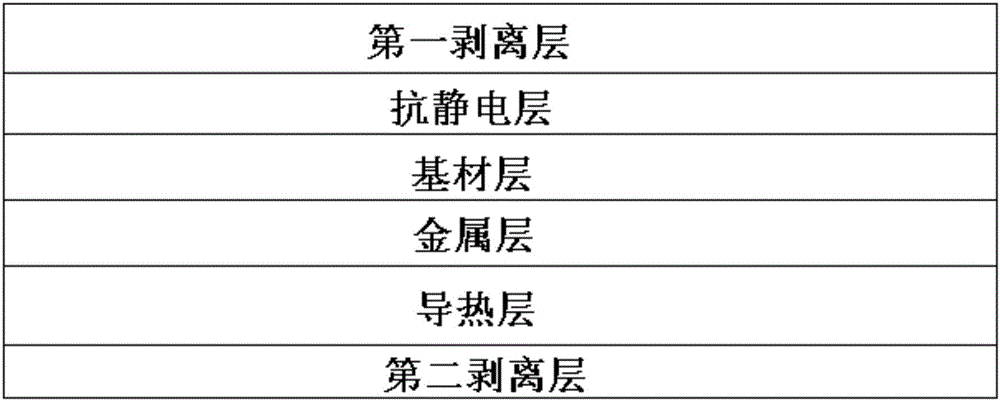Anti-magnetic heat-conducting film and preparation method thereof
A heat-conducting film and heat-conducting layer technology, applied in chemical instruments and methods, coatings, layered products, etc., can solve problems such as poor heat dissipation
- Summary
- Abstract
- Description
- Claims
- Application Information
AI Technical Summary
Problems solved by technology
Method used
Image
Examples
preparation example Construction
[0043] The present invention also provides a method for preparing a diamagnetic heat-conducting film, comprising the following steps:
[0044] A) one side of the substrate is coated with antistatic glue, and cured to obtain a substrate compounded with an antistatic layer;
[0045] B) attaching a peeling film on the surface of the antistatic layer to form the first peeling layer;
[0046] C) plating a layer of metal on the other side of the substrate to form a metal layer;
[0047] D) Coating heat-conducting glue on the surface of the metal layer, and obtaining a heat-conducting layer after curing, heat-conducting particles are dispersed in the heat-conducting glue, and the heat-conducting particles include alumina particles, aluminum hydroxide particles, boron nitride particles and copper-zinc alloy particles one or more of them;
[0048] E) Attaching a release film on the surface of the heat conduction layer to obtain a diamagnetic heat conduction film.
[0049]The present...
Embodiment 1
[0058] On the 50μm thick PET insulating film, apply a 4μm thick antistatic glue with a micro concave roller, and cure it with a UV lamp to obtain an antistatic layer;
[0059] Take a PET film with a thickness of 50 μm, and apply a layer of 10 μm silica gel on one side with a comma-type spatula. After baking and curing, cover the side with the glue on the surface of the antistatic layer to form a peeling layer;
[0060] Plating a layer of metal copper with a thickness of 500nm on the other side of the PET insulating film by sputtering to form a metal layer;
[0061] Coating a layer of thermally conductive adhesive on the surface of the copper metal layer, baking and curing to form a 10 μm thick thermally conductive layer, and finally covering a layer of 50 μm thick release film to obtain a diamagnetic thermally conductive film.
Embodiment 2
[0063] Apply 5 μm thick antistatic glue on the 50 μm thick PET insulating film with a micro concave roller, and cure it with a UV lamp to obtain an antistatic layer;
[0064] Take a PET film with a thickness of 50 μm, and apply a layer of 10 μm silica gel on one side with a comma-type spatula. After baking and curing, cover the side with the glue on the surface of the antistatic layer to form a peeling layer;
[0065] A layer of 300nm thick metal copper is plated on the other side of the PET insulating film by sputtering to form a metal layer;
[0066] Coating a layer of thermally conductive adhesive on the surface of the copper metal layer, baking and curing to form a 25 μm thick thermally conductive layer, and finally covering a layer of 50 μm thick release film to obtain a diamagnetic thermally conductive film.
PUM
| Property | Measurement | Unit |
|---|---|---|
| particle diameter | aaaaa | aaaaa |
| thickness | aaaaa | aaaaa |
| thickness | aaaaa | aaaaa |
Abstract
Description
Claims
Application Information
 Login to View More
Login to View More - Generate Ideas
- Intellectual Property
- Life Sciences
- Materials
- Tech Scout
- Unparalleled Data Quality
- Higher Quality Content
- 60% Fewer Hallucinations
Browse by: Latest US Patents, China's latest patents, Technical Efficacy Thesaurus, Application Domain, Technology Topic, Popular Technical Reports.
© 2025 PatSnap. All rights reserved.Legal|Privacy policy|Modern Slavery Act Transparency Statement|Sitemap|About US| Contact US: help@patsnap.com

